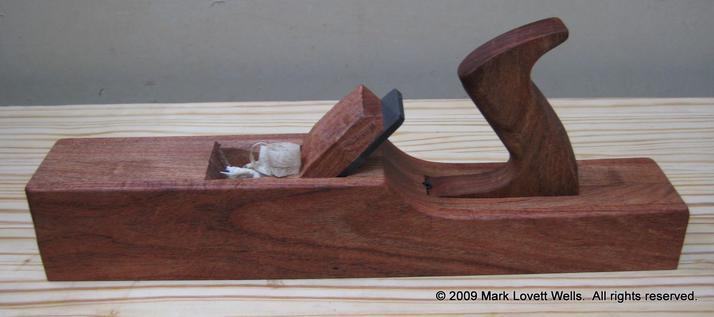
I made this jack plane in the style of UK planemaker Philip Edwards. I have been experimenting with different plane styles. This is the fourth plane that I’ve made, and I think it is the best so far.
Philly Style bench planes are laminated. The bed for the iron and the abutments are cut from the center block. Two thin slabs are glued on the sides. The construction is somewhat similar to a Krenov style plane, but it has a traditional abutments rather than a cross pin. Note that as you build the plane, the abutments remain attached to the center block. I have never seen this style of plane before, but I think it’s brilliant. Laminating the plane makes it much easier to construct and doesn’t require any specialized woodworking tools.
There are two articles I know of in which Edwards describes his process. One on his website, and the second in Get Woodworking magazine. Edwards wrote a series of articles for Get Woodworking on how to make different planes, but I have not read them. As far as I can tell, Get Woodworking is only available in the UK. Derek Cohen also built a plane in the same style and documented it on his website.
My plane is made from 4/4 mesquite, which is locally available. The iron is a massive 3/16" thick, 1 7/8" wide, and 6" long. I purchased it from Lee Valley. I ground an 8" radius in the cutting edge as recommended by Christopher Schwarz for a course fore or jack plane. Schwarz’s grinding procedure works well. I used a belt sander rather than a wheel grinder. The grinding takes a while because Lee Valley annoying puts a 30° bevel on their blades and I prefer a 25° bevel. Once you get past that, you are fine.
According to Perch & Lee, traditional wooden jack planes have a 2 1/8" wide iron. However, when I grind an 8" radius on an iron that wide, I find that I end up using a pretty narrow strip in the middle of the blade, so I decided to go with a more narrow iron. The Clark & Williams jack is even more narrow than mine, so at least there is some precedent.
Edwards instructions did not provide all the dimensions I needed. I filled in the gaps from the Perch & Lee book, Wooden Planes and How to Make Them. The book Making Traditional Planes by John Whelan is also helpful, but I think you could get by with just the Perch & Lee book. Both books cover alternative methods for laminating planes, but I think Edwards has the best idea. The first few planes I made were based on David Finck’s book Making and Mastering Wood Planes. Finck’s book is by far the most detailed because it only covers making one Krenov-style plane. If you plan on making wooden planes, you’ll probably end up with all three books.
The tote is based on the pattern that Lee Valley publishes with the sales material for their Variable Round-Over Router Bit. As I used a rasp to clean up the tote, I thought about how happy I was to not be using a $65 router bit. I am not confident that I won’t need to tweak the tote, especially after my experience with my jointer plane, so the tote is attached with a single screw.
I think a jack plane is a good place to start because it is very forgiving. The mouth does not have to be very tight, the thick shavings are less likely to get stuck under the wedge or other places, and the sole doesn’t have to be absolutely flat.
I have been using this plane for several months and I love it. If you want to start making wooden planes, I think this would be a great place to start. Of course you could also buy one from Philip!
